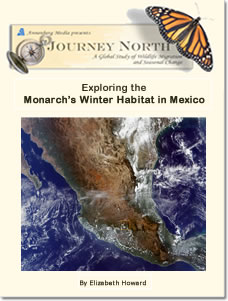Teaching
Suggestions
Exploring the Monarch's Winter Habitat in Mexico
Overview
This slideshow tells a story of discovery. Students learn that scientists did not know about the monarch's winter home in Mexico until 1975. Scientists discovered that monarchs migrate each fall to an astonishingly small region in Mexico that measures only 73 miles wide. Within it, the monarchs gather on only 12 mountain sanctuaries where they cluster in colonies by the tens of millions. These mountain sanctuaries provide the unique conditions monarchs need to survive the winter, from November until mid-March. Use this story as a springboard to explore the essential question:
| Essential Question |
| What conditions make the monarch's overwintering habitat in Mexico ideal for survival? |
Identify Scientists' Questions
Encourage
students to identify the questions scientists had when they discovered
the monarch's winter home in Mexico. What was surprising about the place?
What are the conditions like? (forest habitat, cold temperatures, high
elevation, mountain landscape, few flowers/little food, located in central
Mexico, unique microclimate).
Explore Rare Habitat
Use Journal
Page #1 to explore a map of Mexico and see how rare the monarch's
winter habitat is. The monarch sanctuaries are in a rare type of forest
called the oyamel fir forest. Ask, Why is it important to conserve
the oyamel forest in Mexico? Challenge students to collect different
kinds of maps to learn about the unique characteristics of the monarch’s
winter habitat.
Measure and Compare
Use Journal
Page #2 to explore the size of the monarch overwintering region.
Measure distances and compare on a local map for a personal connection.
Consider risks and benefits. Ask, What are the benefits and risks
of having so many monarchs overwinter in one small region?
Learn
about "microclimates" by finding examples in your surroundings.
(Brainstorm what this word might mean. Try breaking it down into the
words "micro" and "climate.") Have
students take temperature readings in different locations on your school
grounds. The areas you explore may have different microclimates.
Differences in temperature, humidity, wind, and exposure to the sun
are factors that can cause microclimate conditions. (See
sample map.)
|
What is a Microclimate? |
A
microclimate is the climate of a local area where climate conditions
differ from the surrounding, general area. |
Writing Prompt: Discuss this statement: "The fact that the monarchs can survive for five winter months in Mexico is as amazing as the monarch's spectacular migration." Compare facts about fall monarch migration and the monarch's overwintering season in Mexico.
Journal
Page #1
Why is it important to conserve the oyamel forest in Mexico?
Journal
Page #2
Explore the size of the monarch overwintering region!






